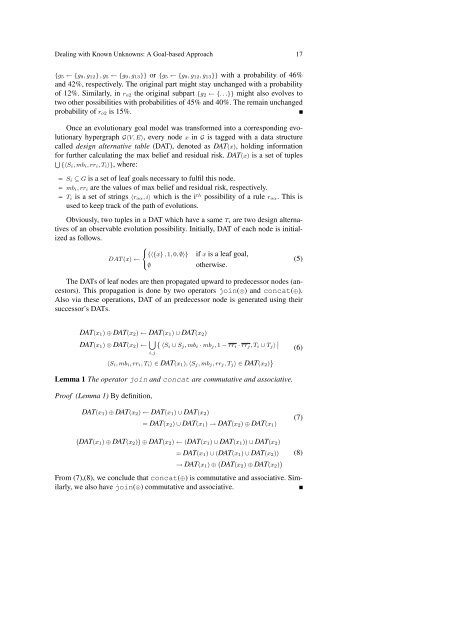D.3.3 ALGORITHMS FOR INCREMENTAL ... - SecureChange
D.3.3 ALGORITHMS FOR INCREMENTAL ... - SecureChange
D.3.3 ALGORITHMS FOR INCREMENTAL ... - SecureChange
You also want an ePaper? Increase the reach of your titles
YUMPU automatically turns print PDFs into web optimized ePapers that Google loves.
Dealing with Known Unknowns: A Goal-based Approach 17<br />
{g 5 ← {g 9 , g 12 } , g 5 ← {g 9 , g 13 }} or {g 5 ← {g 9 , g 12 , g 13 }} with a probability of 46%<br />
and 42%, respectively. The original part might stay unchanged with a probability<br />
of 12%. Similarly, in r o2 the original subpart {g 2 ← {. . .}} might also evolves to<br />
two other possibilities with probabilities of 45% and 40%. The remain unchanged<br />
probability of r o2 is 15%.<br />
Once an evolutionary goal model was transformed into a corresponding evolutionary<br />
hypergraph G〈V, E〉, every node x in G is tagged with a data structure<br />
called design alternative table (DAT), denoted as DAT(x), holding information<br />
for further calculating the max belief and residual risk. DAT(x) is a set of tuples<br />
S {〈Si , mb i , rr i , T i 〉}, where:<br />
– S i ⊆ G is a set of leaf goals necessary to fulfil this node.<br />
– mb i , rr i are the values of max belief and residual risk, respectively.<br />
– T i is a set of strings 〈r oα, i〉 which is the i th possibility of a rule r oα. This is<br />
used to keep track of the path of evolutions.<br />
Obviously, two tuples in a DAT which have a same T i are two design alternatives<br />
of an observable evolution possibility. Initially, DAT of each node is initialized<br />
as follows.<br />
8<br />
< {〈{x} , 1, 0, ∅〉} if x is a leaf goal,<br />
DAT (x) ←<br />
(5)<br />
: ∅<br />
otherwise.<br />
The DATs of leaf nodes are then propagated upward to predecessor nodes (ancestors).<br />
This propagation is done by two operators join(⊗) and concat(⊕).<br />
Also via these operations, DAT of an predecessor node is generated using their<br />
successor’s DATs.<br />
DAT(x 1 ) ⊕ DAT(x 2 ) ← DAT(x 1 ) ∪ DAT(x 2 )<br />
DAT(x 1 ) ⊗ DAT(x 2 ) ← [ i,j<br />
˘<br />
〈Si ∪ S j , mb i · mb j , 1 − rr i · rr j , T i ∪ T j 〉 ˛˛<br />
〈S i , mb i , rr i , T i 〉 ∈ DAT(x 1 ), 〈S j , mb j , rr j , T j 〉 ∈ DAT(x 2 )¯<br />
(6)<br />
Lemma 1 The operator join and concat are commutative and associative.<br />
Proof (Lemma 1) By definition,<br />
DAT(x 1 ) ⊕ DAT(x 2 ) ← DAT(x 1 ) ∪ DAT(x 2 )<br />
= DAT(x 2 ) ∪ DAT(x 1 ) → DAT(x 2 ) ⊕ DAT(x 1 )<br />
(7)<br />
`DAT(x1 ) ⊕ DAT(x 2 )´ ⊕ DAT(x 2 ) ← (DAT(x 1 ) ∪ DAT(x 1 )) ∪ DAT(x 2 )<br />
= DAT(x 1 ) ∪ (DAT(x 1 ) ∪ DAT(x 2 ))<br />
→ DAT(x 1 ) ⊕ `DAT(x 2 ) ⊕ DAT(x 2 )´<br />
From (7),(8), we conclude that concat(⊕) is commutative and associative. Similarly,<br />
we also have join(⊗) commutative and associative.<br />
(8)


